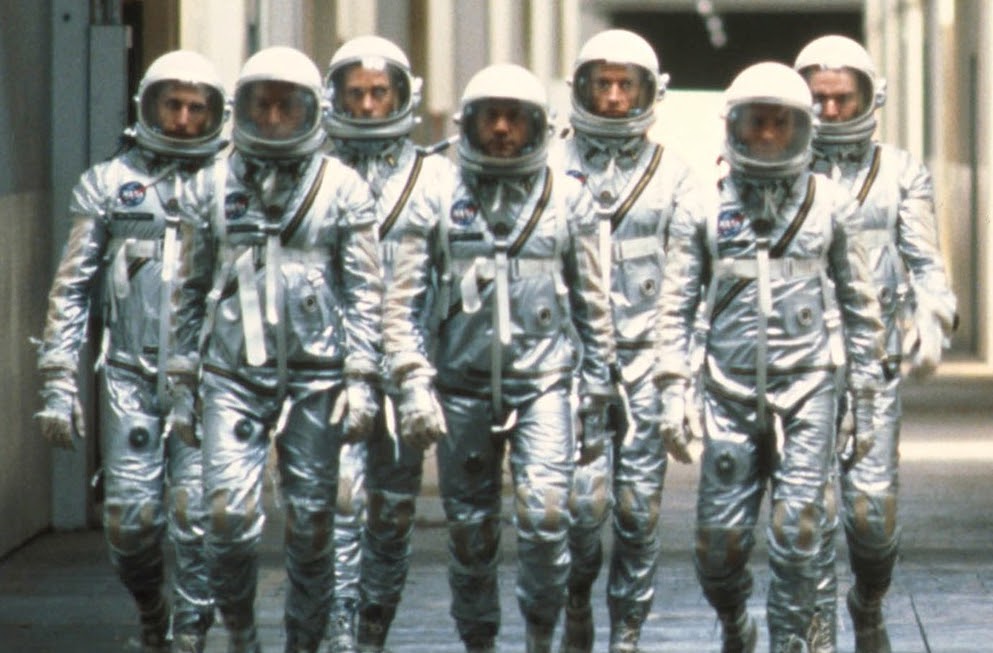Have You Got The Right Stuff? The SPYSCAPE Glossary of Astronaut Jargon
Since Neil Armstrong’s giant leap for mankind in 1969, we’ve been mesmerized by space - although the indecipherable language can be a bit tricky.
If you're confused by ‘puffy head bird legs’ references and ‘rendezvous communities’, you’re not alone. NASA staff in Washington, DC decode their secret language with a 305-page guide describing almost 5,000 terms. (And yes, the colorful phrase ‘screw the pooch’ really can be traced back to NASA!)
SPYSCAPE helps you master the lingo to ensure you’ve got The Right Stuff.

Abort - Missions are cut short or canceled using aborts: a ‘pad’ abort occurs after ignition of the main engines but prior to liftoff; an ‘intact’ abort happens during ascent, and; a ‘contingency’ abort occurs with the failure of more than one main engine.
Acronyms - NASA has never met an acronym it didn’t like - from MUM (mass memory unit manager) to POD (payload operations director), and SMU (speaker-microphone unit). There’s too many to note, but if you’re an acronym-phile NASA’s DIY E/PO is your nirvana.
Airlock - Often just called a ‘lock’, an airlock is a compartmentalized room with parallel doors to allow astronauts to move between areas that are at different pressures. Alien fans may recall Ellen Ripley (Sigourney Weaver) dealing with the Xenomorph in the airlock.
Astronaut - NASA came up with the word for its pilots. ‘Astro’ refers to space travelers or star travelers. The word ‘naut’ comes from the Greek word for sailor, later generalized to mean traveler.
Command module - The compartment of a spacecraft that carries the crew, communications equipment and controls. The Apollo 11 command module, Columbia, was the living quarters for Neil Armstrong, Edwin ‘Buzz’ Aldrin and Michael Collins during the first crewed moon landing mission in 1969, the only portion of the spacecraft to return to Earth.
Computational fluid dynamics - The science of airflow.
"The brand new social experience where you activate your gaming skills as you train like a spy."
- TimeOut
Take on thrilling, high-energy espionage challenges across different game zones.


Cosmonaut - The Russian equivalent of an astronaut, with ‘cosmos’ referring to the universe and ‘naut’ meaning traveler. In the movie Sputnik, Oksana Akinshina plays a young doctor examining a cosmonaut with an alien parasite.
Deep Yogurt - Trouble.
Downlink - A radio signal sent from a spacecraft to Earth.

Disintegrate - Break into small parts as the result of impact or decay. In 2020, the Hubble Space Telescope watched the comet Atlas disintegrate into more than two dozen pieces.
G-force - Gravitational force equivalent (g-force) is used to convey values of force and acceleration, but you’ll want to fasten your seatbelt before listening to NASA’s explanation: “One g is the force per unit mass due to gravity at the Earth's surface and is the standard gravity defined as 9.80665 meters per second squared, or equivalently 9.80665 newtons of force per kilogram of mass.” So there’s that...
Glitch - A snag or malfunction, usually temporary. NASA’s Ingenuity helicopter, for example, landed on Mars after wobbling, power spikes, and velocity fluctuations on its sixth flight.
Gravity - The force by which a planet or other body draws objects toward its center. The force of gravity keeps the planets in orbit around the sun.
Houston - Shorthand for The Lyndon B. Johnson Space Center, NASA's center for human spaceflight training, research, and flight control based in Houston, Texas.

‘Houston, we’ve had a problem’ - At about 55 hours into the Apollo 13 mission, oxygen tank No. 2 exploded, causing the No. 1 tank to also fail. The command module's normal supply of electricity, light, and water was lost with the crew about 200,000 miles from Earth. Although Apollo 13 did safely return, the crew circled the moon rather than land. The phrase entered the lexicon as an ironic understatement to describe an unforeseen problem.
Keyhole - A gravitational keyhole is a small region of space where a planet's gravity would alter the orbit of a passing asteroid in such a way that the asteroid would collide with that planet on a future orbital pass.
Liftoff - Liftoff occurs when a rocket leaves the launch pad.

L- and T- (pronounced L-minus and T-minus) - L- refers to the days, hours, and minutes left until the launch at L-0. T- refers to the time remaining until launch on the official countdown clock.
LOX - Stands for liquid oxygen, which, when combined with fuel, creates a propellant that can be used to launch a rocket.
MES and MECO - MES, or Main Engine Start, refers to the moment the main engine begins to fire. MECO, for Main Engine Cut Off, refers to the moment when the main engine burn is completed and cut off, entering a coasting phase.
Nadir - The downward direction from a spacecraft to the center of a planet below.
No Go - Canceled.

Nondestructive inspection - Radiography, like X-rays or other methods, to examine a particular area or thing without tearing it apart.
Phase locked - When an FM receiver tunes in a broadcast station, it locks onto the signal using an internal circuit called a phase-locked loop.
Protuberance air load - A ramp.
Puffy head bird legs - If you’ve ever hung upside down and felt the blood rushing to your head you will know what the astronauts experience in space. Puffy head bird legs describes the sensation of having a large, puffy head atop thin legs.
Raffaello multi-purpose logistics module - As in: “We’re unloading cargo from the MPLM-2”, which is a space shuttle container. The Raffaello model, the primary payload on the final Space Shuttle, was constructed by the Italian Space Agency and named after painter and architect Raffaello Sanzio.
Rendezvous community - A meeting.
Screw the pooch - A blunder, an embarrassing mistake. The phrase is used in Tom Wolfe’s 1979 novel The Right Stuff, about the Project Mercury astronauts selected for the NASA space program. The phrase has been traced back to NASA and the US Navy in the 1950s.

Some words - “We have some words for you about the signal light issue.” The words offer advice or instructions from ground control.
Spacecraft Event Time - Local time for events that occur aboard the spacecraft (Earth time minus the elapsed time between Earth and the spacecraft).
Unity module - The international space station.
V-2 - The history of space flight began in 1942 with the development of the V-2 rocket by Germany, the first vehicle capable of reaching the 100km (62m) boundary of space. Three V-2 rockets launched successfully on test flights in 1942.
Uplink - A radio signal sent from Earth to a spacecraft.
Zenith - The point on a planet directly above the spacecraft (opposite the nadir).

Zero gravity - The state or condition of weightlessness in which there is no apparent force of gravity acting on a body, either because the force is weak, or because the body and its surroundings are freely and equally accelerating under the force.
Ready to ramp up your space jargon a notch? Try NASA’s basics of space flight and the European Space Agency’s glossary. After all, the sky’s the limit.
SPYSCAPE+

Join now to get True Spies episodes early and ad-free every week, plus subscriber-only Debriefs and Q&As to bring you closer to your favorite spies and stories from the show. You’ll also get our exclusive series The Razumov Files and The Great James Bond Car Robbery!


Gadgets & Gifts
Explore a world of secrets together. Navigate through interactive exhibits and missions to discover your spy roles.
Your Spy Skills
We all have valuable spy skills - your mission is to discover yours. See if you have what it takes to be a secret agent, with our authentic spy skills evaluation* developed by a former Head of Training at British Intelligence. It's FREE so share & compare with friends now!
* Find more information about the scientific methods behind the evaluation here.


Stay Connected
Follow us for the latest
TIKTOK
INSTAGRAM
X
FACEBOOK
YOUTUBE